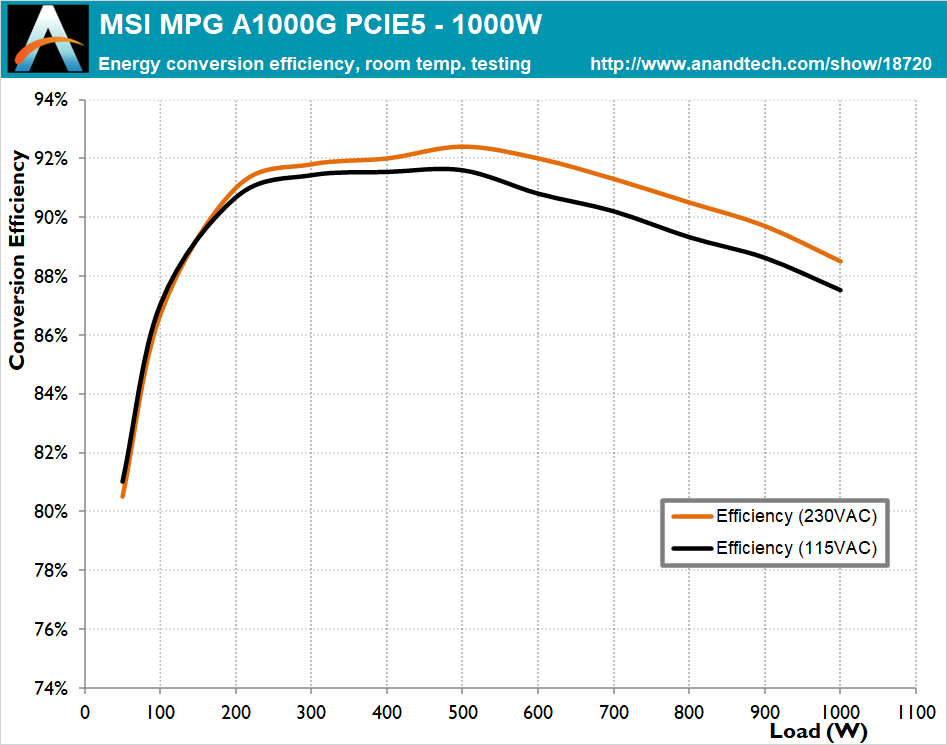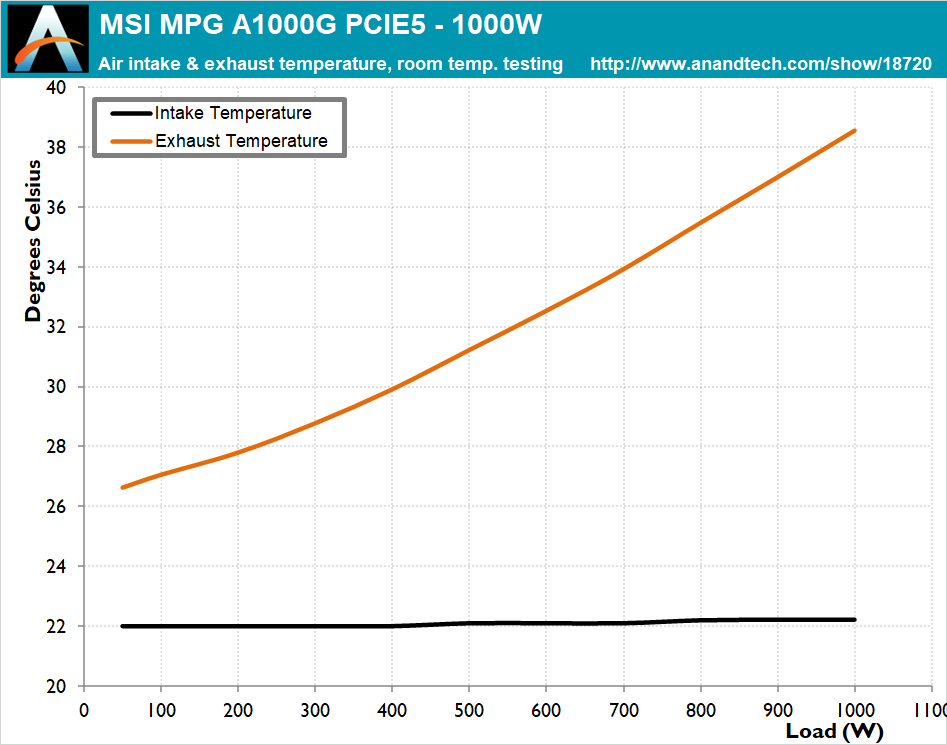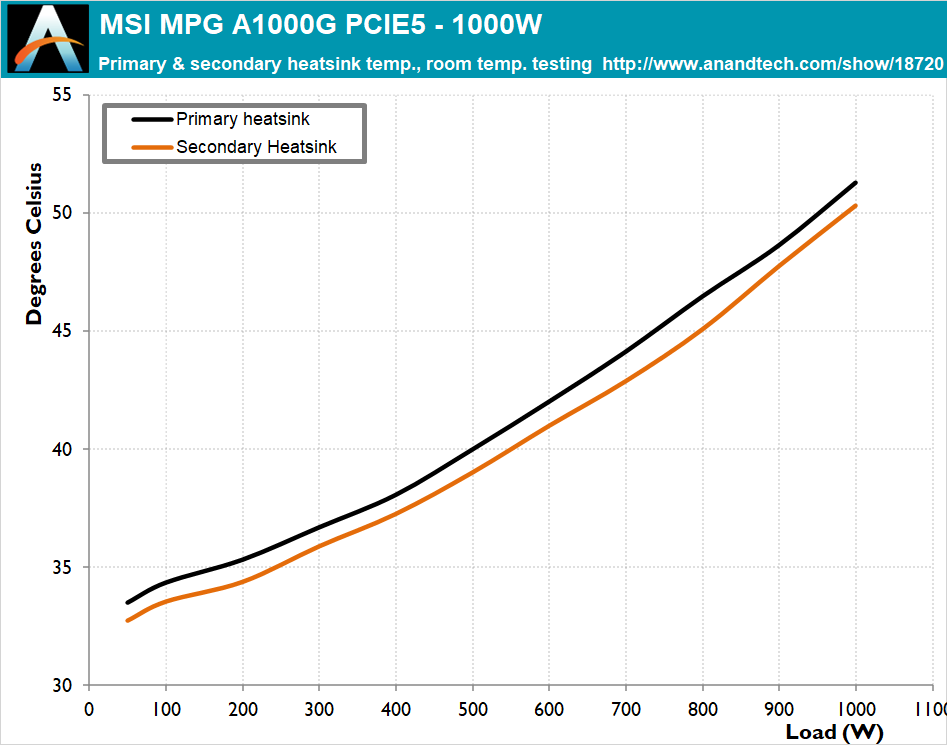The MSI MPG A1000G PCIE5 PSU Review: Balance of Power
by E. Fylladitakis on February 2, 2023 1:00 PM EST- Posted in
- Cases/Cooling/PSUs
- PSUs
- MSI
- 80Plus Gold
- ATX v3.0
- 12VHPWR
Cold Test Results (~22°C Ambient)
For the testing of PSUs, we are using high precision electronic loads with a maximum power draw of 2700 Watts, a Rigol DS5042M 40 MHz oscilloscope, an Extech 380803 power analyzer, two high precision UNI-T UT-325 digital thermometers, an Extech HD600 SPL meter, a self-designed hotbox and various other bits and parts. For a thorough explanation of our testing methodology and more details on our equipment, please refer to our How We Test PSUs - 2014 Pipeline post.
When the load is relatively low, the conversion efficiency of the MSI MPG A1000G PCIE5 is wondrously high for an 80Plus Gold certified product, especially while the unit is powered by an 115 VAC source. If not for the swift decline at loads greater than 600 Watts, this unit might have gotten an 80Plus Platinum certification instead. At very low loads, the MPG A1000G PCIE actually is more efficient if powered from an 115 VAC source but, as it usually is the case with such switching-mode power supplies, the average efficiency is significantly higher when the input voltage is 230 VAC. The average nominal load efficiency (20% to 100% of the unit's capacity) is 91.0% with the unit powered from a 230 VAC source, and drops down to 90.1% if the unit is powered by a 115 VAC source.
We performed our testing with the “Zero Fan” mode of the unit disabled, forcing the fan to spin regardless of the load. As we suspected, despite that the fan was spinning, the MPG A1000G PCIE is practically inaudible while the load is lower than about 350 Watts. The high low load conversion efficiency of the unit helps with that, as thermal losses are fairly low and the large fan easily copes with them. The thermal control circuitry reacts very aggressively though and will speed up the fan sharply once the internal temperatures of the unit increase. As such, the MPG A1000G PCIE becomes clearly audible at loads between 50% and 70%. If the load is greater than 700 Watts, the speed of the fan increases very sharply and makes the MPG A1000G PCIE quite loud.















15 Comments
View All Comments
Tom Sunday - Sunday, February 5, 2023 - link
I am about to purchase another PSU. As such it has to be at least 1300W and have full 12VHPWR support. Been seriously looking at the Seasonic PRIME-TX-1300 which comes with (2) 12VHPWR cables. Its unfortunately not totally 3.0 compliant and $460 MSRP is not easy to swallow. I also like the Super Flower Leadex Titanium 1000W 80+Titanium product (they manufacture for EVGA) for its superb quality, but no 12VHPWR news or introductions as of yet!Oxford Guy - Wednesday, March 1, 2023 - link
Watch the noise levels. Seasonic apparently isn't known for making much effort to design quite high-wattage PSUs. Even BeQuiet allegedly has had issues with noisy fans, perhaps due to some QC problem that only affects some of the assembled units. Some BeQuiet models also don't try to be all that quiet, despite the name.The bottom line, in my view, is that the ATX form factor isn't suited for high-wattage PSUs. Nonetheless, the industry refuses to modernize. The same goes for GPUs, where the stubbornness manifests in 3.5-slot cards that blast the case full of heat, or slimmer cards that are much too loud.
brantron - Monday, February 6, 2023 - link
You'd be in the 500 watt range, but only with a GPU bound game and ray tracing. Here are some examples:https://www.techpowerup.com/review/msi-geforce-rtx...
MSI implies that by default, the fan does not run under 40% load:
https://www.msi.com/Power-Supply/MPG-A1000G
This was disabled for the review, but the chart does show a slow ramp above 400 watts.
Khanan - Thursday, February 9, 2023 - link
Interesting.dreamEnd - Saturday, April 1, 2023 - link
Between this and FSP Hydro G, what are the major pros and cons of each PSU and which one is the preferred choice?